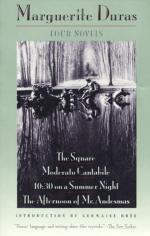|
This section contains 3,590 words (approx. 12 pages at 300 words per page) |

|
SOURCE: “Resolution in Marguerite Duras's ‘Moderato Cantabile,’” in Twentieth Century Literature, Vol. 29, No. 3, 1983, pp. 370-78.
In the following essay, Welcher discusses Duras's use of music and mythology to express her characters' otherwise inexpressible motivations and actions in Moderato cantabile.
As its title announces, Moderato Cantabile by Marguerite Duras is a novel centered on contrasts.1 These range from the paradox of murdering one's beloved; through fine discriminations—“cantabile,” yes, but moderately so; to allusions and inferrable mythic parallels, especially to the myth of Dionysus.
We are struck first by the book's contrasts in style—its extraordinary limpidity, its evident complexities. In a filmmaker's approach Duras presents stark imagery, without background or depth. Her invisible narrator records appearances but virtually no interpretation or judgment. The characters are admittedly unreliable. Chauvin insists that he has no facts; Anne Desbaresdes, that she does not know even her own mind. Both she and...
|
This section contains 3,590 words (approx. 12 pages at 300 words per page) |

|


